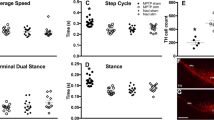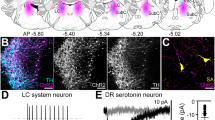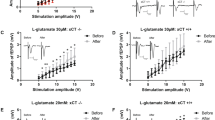Abstract
We report here observations indicating that the rat striatum can be partially protected from the neurotoxic action of locally applied kainic acid (KA, a rigid structural analogue of glutamic acid1) by procedures resulting in reduced serotonergic brain activity. This observation may be important because the striatal damage produced by KA shows morphological and neurochemical similarities to the changes seen in the striata of patients dying of Huntington's chorea2,3, an hereditary brain disorder, and because functional and morphological brain changes induced by KA have been proposed as a close model for human epilepsy4. Our observations thus suggest that serotonergic brain mechanisms influence the development of neuropathological changes accompanying certain neurological disorders.
This is a preview of subscription content, access via your institution
Access options
Subscribe to this journal
Receive 51 print issues and online access
$199.00 per year
only $3.90 per issue
Buy this article
- Purchase on Springer Link
- Instant access to full article PDF
Prices may be subject to local taxes which are calculated during checkout
Similar content being viewed by others
References
Olney, J. W., Rhee, V. & Ho, O. L. Brain Res. 77, 507–512 (1974).
Coyle, J. T. & Schwarcz, R. Nature 263, 244–246 (1976).
McGeer, E. G. & McGeer, P. L. Nature 263, 517–519 (1976).
Ben-Ari, Y., Tremblay, E. & Ottersen, O. P. Neuroscience 5, 515–528 (1980).
König, J. F. R. & Klippel, R. A. The Rat Brain: A Stereotaxic Atlas of the Forebrain and Lower Parts of the Brainstem (Krieger, Huntington, New York, 1970).
Stewart, R. M., Gerson, S. C., Sperk, G., Campbell, A. & Baldessarini, R. J. Ann. N.Y. Acad. Sci. 305, 198–207 (1978).
Koe, B. K. & Weissman, A. J. Pharmac. exp. Ther. 154, 499–516 (1966).
Hamon, M. et al. J. Neurochem. 36, 613–626 (1981).
Miller, J. J., Richardson, T. L., Fibiger, H. C. & McLennan, H. Brain Res. 97, 133–138 (1975).
Olpe, H.-R. & Koella, W. P. Brain Res. 112, 357–360 (1977).
Davies, J. & Tongroach, P. Eur. J. Pharmac. 51, 91–100 (1978).
McGeer, E. G., McGeer, P. L. & Singh, K. Brain Res. 139, 381–383 (1978).
Butcher, S. G., Butcher, L. L. & Cho, A. K. Life Sci. 18, 733–744 (1976).
Nadler, J. V. & Cuthbertson, G. J. Brain Res. 195, 47–56 (1980).
Sperk, G., Berger, M., Hörtnagl, H. & Hornykiewicz, O., Eur. J. Pharmac. 74, 279–286 (1981).
Anderson, K., Schwarcz, R. & Fuxe, K. Nature 283, 94–96 (1980).
Hornykiewicz, O. Adv. Neurol. 23, 679 (1979).
Gersen, S. C. & Baldessarini, R. J. Life Sci. 27, 1435–1451 (1980).
Miller, L. P., Martin, D. L., Mazumder, A., Walters, J. R. J. Neurochem. 30, 361–368 (1978).
Fonnum, F. J. Neurochem. 24, 407–409 (1975).
Sperk, G. J. Neurochem. 38, 840–843 (1982).
Author information
Authors and Affiliations
Rights and permissions
About this article
Cite this article
Berger, M., Sperk, G. & Hornykiewicz, O. Serotonergic denervation partially protects rat striatum from kainic acid toxicity. Nature 299, 254–256 (1982). https://doi.org/10.1038/299254a0
Received:
Accepted:
Issue Date:
DOI: https://doi.org/10.1038/299254a0
This article is cited by
-
Huntington’s disease as a model for mood disorders
Molecular and Chemical Neuropathology (1990)
-
Influence of the plasma glucose level on brain damage after systemic kainic acid injection in the rat
Acta Neuropathologica (1986)
-
Quinolinic acid stimulates luteinizing hormone secretion through a serotonin-dependent mechanism
Experimental Brain Research (1985)
-
Recent advances in the use of selective neuron-destroying agents for neurobiological research
Experientia (1984)
-
Huntington's disease: genetically programmed cell death in the human central nervous system
Nature (1982)
Comments
By submitting a comment you agree to abide by our Terms and Community Guidelines. If you find something abusive or that does not comply with our terms or guidelines please flag it as inappropriate.



